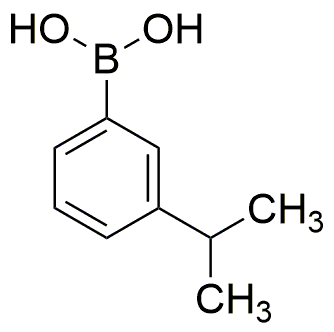3-Isopropylphenylboronic acid is widely utilized in research focused on:
- Organic Synthesis: This compound serves as a key reagent in Suzuki-Miyaura cross-coupling reactions, allowing chemists to create complex organic molecules efficiently. Its ability to form stable complexes with various substrates makes it invaluable in developing pharmaceuticals.
- Drug Development: In medicinal chemistry, it is used to modify drug candidates, enhancing their efficacy and selectivity. The presence of the boronic acid group can improve the solubility and bioavailability of therapeutic agents.
- Bioconjugation: The compound is employed in bioconjugation techniques, facilitating the attachment of biomolecules to surfaces or other molecules. This is particularly useful in creating targeted drug delivery systems and diagnostic tools.
- Material Science: It plays a role in the development of advanced materials, such as polymers and hydrogels, which are used in various applications including drug delivery and tissue engineering due to their tunable properties.
- Environmental Applications: The compound can be utilized in the detection and removal of pollutants, particularly in water treatment processes, by forming complexes with heavy metals and organic contaminants, thus aiding in environmental remediation efforts.
General Information
Properties
Safety and Regulations
Applications
3-Isopropylphenylboronic acid is widely utilized in research focused on:
- Organic Synthesis: This compound serves as a key reagent in Suzuki-Miyaura cross-coupling reactions, allowing chemists to create complex organic molecules efficiently. Its ability to form stable complexes with various substrates makes it invaluable in developing pharmaceuticals.
- Drug Development: In medicinal chemistry, it is used to modify drug candidates, enhancing their efficacy and selectivity. The presence of the boronic acid group can improve the solubility and bioavailability of therapeutic agents.
- Bioconjugation: The compound is employed in bioconjugation techniques, facilitating the attachment of biomolecules to surfaces or other molecules. This is particularly useful in creating targeted drug delivery systems and diagnostic tools.
- Material Science: It plays a role in the development of advanced materials, such as polymers and hydrogels, which are used in various applications including drug delivery and tissue engineering due to their tunable properties.
- Environmental Applications: The compound can be utilized in the detection and removal of pollutants, particularly in water treatment processes, by forming complexes with heavy metals and organic contaminants, thus aiding in environmental remediation efforts.
Documents
Safety Data Sheets (SDS)
The SDS provides comprehensive safety information on handling, storage, and disposal of the product.
Product Specification (PS)
The PS provides a comprehensive breakdown of the product’s properties, including chemical composition, physical state, purity, and storage requirements. It also details acceptable quality ranges and the product's intended applications.
Certificates of Analysis (COA)
Search for Certificates of Analysis (COA) by entering the products Lot Number. Lot and Batch Numbers can be found on a product’s label following the words ‘Lot’ or ‘Batch’.
*Catalog Number
*Lot Number
Certificates Of Origin (COO)
This COO confirms the country where the product was manufactured, and also details the materials and components used in it and whether it is derived from natural, synthetic, or other specific sources. This certificate may be required for customs, trade, and regulatory compliance.
*Catalog Number
*Lot Number
Safety Data Sheets (SDS)
The SDS provides comprehensive safety information on handling, storage, and disposal of the product.
DownloadProduct Specification (PS)
The PS provides a comprehensive breakdown of the product’s properties, including chemical composition, physical state, purity, and storage requirements. It also details acceptable quality ranges and the product's intended applications.
DownloadCertificates of Analysis (COA)
Search for Certificates of Analysis (COA) by entering the products Lot Number. Lot and Batch Numbers can be found on a product’s label following the words ‘Lot’ or ‘Batch’.
*Catalog Number
*Lot Number
Certificates Of Origin (COO)
This COO confirms the country where the product was manufactured, and also details the materials and components used in it and whether it is derived from natural, synthetic, or other specific sources. This certificate may be required for customs, trade, and regulatory compliance.


